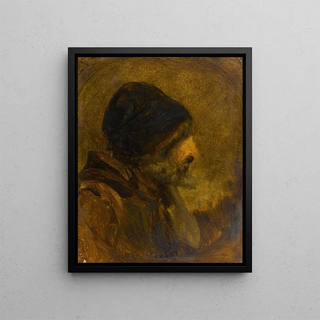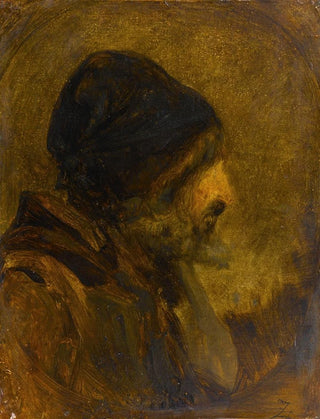Art print | Head of a man after Rembrandt - Félix Ziem


View from behind

Frame (optional)
Rembrandt Head of a Man - Félix Ziem – Captivating Introduction
Félix Ziem's "Head of a Man after Rembrandt" is a work that transcends mere art print reproduction. It embodies a meeting between two artistic eras, a dialogue between the Dutch master of the 17th century and a French painter of the 19th century. Contemplating this piece, the viewer is invited to immerse themselves in a universe where light, shadows, and emotions intertwine, revealing a psychological depth that goes beyond simple imitation. This art print does not merely reproduce a face; it evokes a story, an essence, a humanity that resonates across time.
Style and uniqueness of the art print
Ziem's style in this reproduction is imbued with a delicacy and finesse that are uniquely his own. The brushstrokes, while faithful to the original, demonstrate his ability to breathe new life into a already famous subject. Light plays a crucial role in this work, illuminating the face of the man with a softness that seems almost tangible. The carefully chosen color nuances create an intimate atmosphere, inviting the viewer to approach, to scrutinize every detail, every shadow. Ziem manages to capture the very essence of human emotion, transforming a simple head into a living portrait, full of meaning and soul. This blend of respect for the master and personal interpretation makes this art print a true masterpiece in its own right.
The artist and his influence
Félix Ziem, though less known than some of his contemporaries, had a significant impact on the artistic landscape of his time. Born in Beaune in 1821, he established himself as a painter of landscapes and seascapes, while exploring other genres, such as portraiture. His fascination with light and color led him to develop a unique style, influenced by the great masters but also by emerging Impressionist currents. In confronting Rembrandt, Ziem does not merely imitate; he participates in a tradition while seeking to renew it. His approach reflects a deep respect for art history, while aiming to enrich it.

Matte finish

View from behind

Frame (optional)
Rembrandt Head of a Man - Félix Ziem – Captivating Introduction
Félix Ziem's "Head of a Man after Rembrandt" is a work that transcends mere art print reproduction. It embodies a meeting between two artistic eras, a dialogue between the Dutch master of the 17th century and a French painter of the 19th century. Contemplating this piece, the viewer is invited to immerse themselves in a universe where light, shadows, and emotions intertwine, revealing a psychological depth that goes beyond simple imitation. This art print does not merely reproduce a face; it evokes a story, an essence, a humanity that resonates across time.
Style and uniqueness of the art print
Ziem's style in this reproduction is imbued with a delicacy and finesse that are uniquely his own. The brushstrokes, while faithful to the original, demonstrate his ability to breathe new life into a already famous subject. Light plays a crucial role in this work, illuminating the face of the man with a softness that seems almost tangible. The carefully chosen color nuances create an intimate atmosphere, inviting the viewer to approach, to scrutinize every detail, every shadow. Ziem manages to capture the very essence of human emotion, transforming a simple head into a living portrait, full of meaning and soul. This blend of respect for the master and personal interpretation makes this art print a true masterpiece in its own right.
The artist and his influence
Félix Ziem, though less known than some of his contemporaries, had a significant impact on the artistic landscape of his time. Born in Beaune in 1821, he established himself as a painter of landscapes and seascapes, while exploring other genres, such as portraiture. His fascination with light and color led him to develop a unique style, influenced by the great masters but also by emerging Impressionist currents. In confronting Rembrandt, Ziem does not merely imitate; he participates in a tradition while seeking to renew it. His approach reflects a deep respect for art history, while aiming to enrich it.






